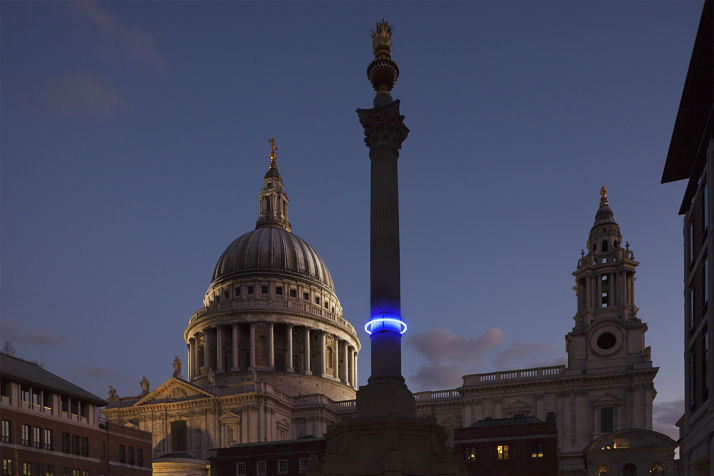[caption id="attachment 8161" align="aligncenter" width="714"][](https://cdn.ecohustler.com/media/2019/03/19/Cover-Image-03 opt.jpg) Plunge project by Arts Admin and artist Michael Pinsky. The monument in Paternoster Square has been fitted with a ring of blue light at 28m above sea levels to indicate where the sea levels will be in 1000 years time if we, the human race, continue our CO2 emmissions at current rate. An estimated hight of raised seal levels will be 28m, based on current available science. 3 monuments in London have been fitted with a ring of light at 28 m above sea levels, one is on the Duke of York Monument, another the monument in Paternoster Square and the third on the monument in Sevel Dials in Covent Garden.[/caption] A new report from the London based sustainability charity [Julie’s Bicycle](http://www.juliesbicycle.com/) and Arts Council England published today has found that England’s arts and cultural sector has made savings of over 12,000 tonnes of C02 emissions and £2.3million in the last two years. The Environmental Sustainability Partnership programme, the first of its kind in the world, was set up in 2012 to track the environmental impact of Arts Council England funded arts and cultural organisations and to inspire them to be more environmentally sustainable. Three years on ‘ Sustaining Great Art’_ shows the results of the Partnership working with over 700 arts organisations across England. Significant findings of the report include:
- 98% of reporting Arts Council funded organisations (700) were involved by 2015 compared to 14% in 2012.
- 40% have gone beyond the Arts Council’s reporting requirements.
- 80%now consider themselves engaged or very engaged with environmental sustainability1.
- Between 2013 and 2015 £2.3m was saved with an average annual 5% decrease in CO2 emissions despite growth of the sector2.
- 51% reported financial benefits, and 70% found their environmental policy useful when applying for funding.
- Scaling these results up across the entire sector would see savings of £15m in just two years3.
The results indicate that the country’s arts and cultural sector is now leading in sustainable behaviour change. These findings will be shared with global leaders at the COP21 UN Climate conference in Paris in December as an example of best practice in tackling climate change. From the installation of solar panels to the production of plays addressing climate change, the sector has seen a step change in sustainability in the past three years. The UK’s leading theatres, galleries, museums, tours, festivals and concert halls are now reporting on energy and water use thanks to tools developed in conjunction with The University of Oxford. Culture Minister Ed Vaizey MP commented on the initiative: "Our arts organisations are some of the most innovative in the world and I’m incredibly proud to see the UK’s theatres, music venues and galleries taking action on climate change with this bold new programme." Alison Tickell, Founder and Director of Julie’s Bicycle said: “The UK’s creative industries have long been celebrated for their talent, now we have another reason to recognise their leadership. They’re shaping a stronger, progressive and sustainable arts for us all. There are three simple ideas at the heart of this programme. First that climate change is not confined to the corridors of politics, business and science, but it is a cultural issue. Second, that collective environmental knowledge and action delivered collaboratively and at scale will lead to cultural change. Third, the creative community has a vital role to play in shaping our future. We’re looking forward to continuing our work with Arts Council England over the next three years, it’s an exciting time packed with innovation and potential for us all.” Darren Henley, Chief Executive, Arts Council England, added: “Caring about the world we live in shouldn't be an optional extra for any of us. Not only is there a moral case for helping arts organisations, museums and libraries to become environmentally sustainable, it makes good business sense too. I'm proud of what our partnership with Julie’s Bicycle has achieved so far and there's more to come over the next three years. In this area, as in so many others, art and culture can make a huge difference to all our lives.” A dedicated programme of events, networking and resources has been delivered by Julie’s Bicycle over the course of the three years to help organisations develop current and effective environmental policies and action plans. These resources are now used by arts organisations from 178 countries across the globe. Julie's Bicycle and Arts Council England launch the Environmental Sustainability Partnership results at their ‘Culture and Sustainability’ event on 11th November at The Tetley in Leeds. They will share insights on how arts and culture are addressing and benefiting from environmental sustainability, and what role the creative sector will play at COP21.




